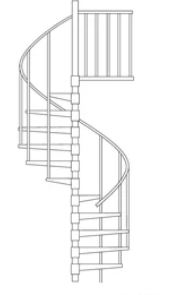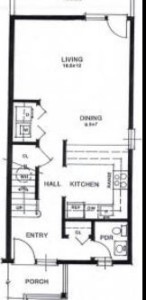
One of the biggest concerns that Feng Shui adherents ask about is the infamous staircase aligned directly with a door. The notion is that this drives the air currents (qi flow) too quickly and directly. Whether the qi is traveling in or out, the concept is that the energy does not adequately circulate in the house and the occupants can suffer one way of the other when the base of the stairs is aligned directly with the main door.
We often emphasize the inability to save money when the stair is aligned directly with the door, but health could be undermined as well. If a house does not circulate its qi properly, it is almost like depriving a person of enough oxygen. This is an exaggeration of course, but over time, these feng shui design flaws can weaken a person.
I field a lot more questions about staircases, to include:
- Are curved stairs better or worse than a straight staircase?
- Is a staircase in the center of a house good or bad?
- What about the corkscrew type of staircase?
- What about a staircase in a split level home?
- Does a staircase need risers on the back of each step?
- Is it good or bad if a staircase is outside a house or building?
- Do stairs need to be carpeted?
- Should a staircase railing be wood or metal?
- Are escalators good or bad Feng Shui?
- What about powder rooms and storage under a staircase?
Most of these questions are specific to the house and I hesitate to make generalities. For example, a staircase in the middle of a house could stir up the ‘center’ stars, which are not actually stationed in the literal center of a house, but they travel through the whole house. Like a vortex, the geometric center of a house can be important. If the “center” stars are inherently positive, then the extra activity of occupants dashing up and down the stairs could stimulate that energy even further. In my second book, The Feng Shui Matrix, I have a whole chapter on the “hidden agenda” of each house, the center energy.
As purveyors of energy, it will matter if the staircase has risers and the degree in which it is curved as that can manipulate qi flow are readily as furnishings and other décor items in the house. There is nothing inherently good for bad about carpeted stairs, but as a practical matter they would be safer and occupants less likely to slip on the stairs.
A very common floor plan for two level apartments and condos has the main entrance aligned with a staircase and little space to place buffers, like a plant or fountain, to slow down the direct path of qi.

A staircase that begins on a lower floor, turned away from the front door should be a non-issue. These are some of the basics covered in my case study on The Nature of Qi.
As with other feng shui design flaws, there often have to be compounding flaws in order to bring about a serious result, such as poorly aligned stairs in conjunction with unfavorable flying stars, other undermining décor features or the occupant’s inherent incompatibility with the entrance location.
Author: Kartar Diamond
Company: Feng Shui Solutions ®
From the Feng Shui Architecture & Design Blog Series
